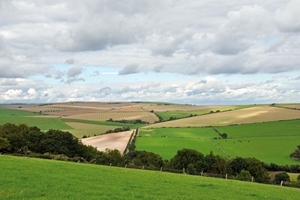 Farmers can help to conserve hares by improving cover and grazing conditions.
Farmers can help to conserve hares by improving cover and grazing conditions.
On arable farms, cereal crops provide abundant cover in summer, but in winter, provided the character of the landscape remains open, game crops, hedgerows and small woodlands will benefit hares. However, grazing conditions are often very poor on arable farms in summer when the crops have lengthened. On these farms the little remaining grass along field boundaries and tracks may be the only grazing available for adults and leverets alike. Providing more grass in the form of strips or patches of pasture is the best way to improve habitat on arable farms. It can be achieved by choosing grass margin, field corner and nectar mix options within stewardship.
On livestock farms, cover is usually the limiting factor. Most areas of grass are either grazed or cut for silage in summer. There may be few areas where leverets can hide and they may be very exposed to foxes which patrol the fields at night. Keeping some areas such as banks, ditch sides and other features fenced off from
livestock will allow the tall grass to develop.
High numbers of foxes on any farm will limit hare numbers. Grass cutting also kills many leverets, so steps should be taken, if possible, to cut in a way that reduces this risk to a minimum.
Dos and don’ts for farmers
 |
Hares like a ‘patchwork quilt’ farmland. Break up large blocks of cereal as much as possible. |
 |
Use areas of wild bird mix, pollen and nectar and grass areas to create cover and food for hares. |
 |
Hares need quiet, undisturbed cover for raising leverets. On livestock farms leave some areas of grass uncut and ungrazed for leverets to hide in. |
 |
When making silage, cut the field from the centre outwards rather than from the outside in, so that hares can escape the machinery into neighbouring fields. |
 |
Planting game crops for pheasants will provide cover and food for hares. |
 |
Don’t shoot hares in late winter unless you are sure crops are being damaged. A February hare shoot can remove 60% of the breeding stock. |
 |
Don’t let poaching jeopardise the hare population. Contact the local police Wildlife Liaison Officer to get help on this. |